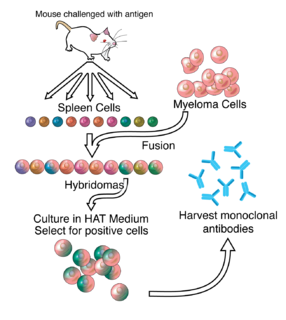
Ibritumomab tiuxetan, sold under the trade name Zevalin, is a monoclonal antibody radioimmunotherapy treatment for relapsed or refractory, low grade or transformed B cell non-Hodgkin's lymphoma, a lymphoproliferative disorder. The drug uses the monoclonal mouse IgG1 antibody ibritumomab in conjunction with the chelator tiuxetan, to which a radioactive isotope is added. Tiuxetan is a modified version of DTPA whose carbon backbone contains an isothiocyanatobenzyl and a methyl group.
Hubert Jacob Paul Schoemaker was a Dutch biotechnologist. He was a co-founder and the president of one of America's first biotechnology companies, Centocor, which was founded in 1979 for the commercialising of monoclonal antibodies. In 1999 he founded Neuronyx, Inc., for the manufacture of stem cells and the development of stem-cell therapies.
The nomenclature of monoclonal antibodies is a naming scheme for assigning generic, or nonproprietary, names to monoclonal antibodies. An antibody is a protein that is produced in B cells and used by the immune system of humans and other vertebrate animals to identify a specific foreign object like a bacterium or a virus. Monoclonal antibodies are those that were produced in identical cells, often artificially, and so share the same target object. They have a wide range of applications including medical uses.

Janssen Biotech, Inc., formerly Centocor Biotech, Inc., is a biotechnology company that was founded in Philadelphia in 1979 with an initial goal of developing new diagnostic assays using monoclonal antibody technology.
Ustekinumab, sold under the brand name Stelara, is a human monoclonal antibody used to treat psoriasis.
Indium (111In) altumomab pentetate (INN) is a mouse monoclonal antibody linked to pentetate which acts as a chelating agent for the radioisotope indium-111. The drug is used for the diagnosis of colorectal cancer.
Indium (111In) capromab pendetide is used to image the extent of prostate cancer. Capromab is a mouse monoclonal antibody which recognizes a protein found on both prostate cancer cells and normal prostate tissue. It is linked to pendetide, a derivative of DTPA. Pendetide acts as a chelating agent for the radionuclide indium-111. Following an intravenous injection of Prostascint, imaging is performed using single photon emission computed tomography (SPECT).
Indium (111In) igovomab was a mouse monoclonal antibody for the diagnosis of ovarian cancer.
Indium (111In) satumomab pendetide is a mouse monoclonal antibody which is used for cancer diagnosis. The antibody, satumomab, is linked to pendetide, a derivative of DTPA. Pendetide acts as a chelating agent for the radionuclide indium-111.
Indium (111In) imciromab is a mouse monoclonal antibody labelled with the radioisotope Indium-111. It was used for cardiac imaging, but withdrawn in 1993.
Priliximab is a human-mouse chimeric anti-CD4 monoclonal antibody. It has been tested on patients with Crohn's disease and multiple sclerosis but has not yet received U.S. Food and Drug Administration licensing. The patent belongs to the biotechnology company Centocor.
ATC code V09Diagnostic radiopharmaceuticals is a therapeutic subgroup of the Anatomical Therapeutic Chemical Classification System, a system of alphanumeric codes developed by the WHO for the classification of drugs and other medical products. Subgroup V09 is part of the anatomical group V Various.
Immunoscintigraphy is a nuclear medicine procedure used to find cancer cells in the body by injecting a radioactively labeled antibody, which binds predominantly to cancer cells and then scanning for concentrations of radioactive emissions.

An octreotide scan or octreoscan is a type of scintigraphy used to find carcinoid, pancreatic neuroendocrine tumors, and to localize sarcoidosis. It is also called somatostatin receptor scintigraphy (SRS). Octreotide, a drug similar to somatostatin, is radiolabeled with indium-111, and is injected into a vein and travels through the bloodstream. The radioactive octreotide attaches to tumor cells that have receptors for somatostatin. A gamma camera detects the radioactive octreotide, and makes pictures showing where the tumor cells are in the body.

Technetium (99mTc) exametazime is a radiopharmaceutical sold under the trade name Ceretec, and is used by nuclear medicine physicians for the detection of altered regional cerebral perfusion in stroke and other cerebrovascular diseases. It can also be used for the labelling of leukocytes to localise intra-abdominal infections and inflammatory bowel disease. Exametazime is sometimes referred to by its chemical name of hexamethylpropyleneamine oxime or HMPAO.
Indium-111 (111In) is a radioactive isotope of indium (In). It decays by electron capture to cadmium-111 with a half-life of 2.8 days.
The indium white blood cell scan, is a nuclear medicine procedure in which white blood cells are removed from the patient, tagged with the radioisotope Indium-111, and then injected intravenously into the patient. The tagged leukocytes subsequently localize to areas of relatively new infection. The study is particularly helpful in differentiating conditions such as osteomyelitis from decubitus ulcers for assessment of route and duration of antibiotic therapy.

Pendetide (GYK-DTPA) is a chelating agent. It consists of pentetic acid (DTPA) linked to the tripeptide glycine (G) – L-tyrosine (Y) – L-lysine (K).
Intetumumab is a human monoclonal antibody that was being studied for the treatment of solid tumors.
Sirukumab is a human monoclonal antibody designed for the treatment of rheumatoid arthritis. It acts against the proinflammatory cytokine Interleukin 6 (IL-6).







